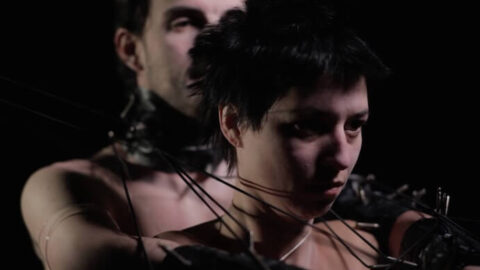Arriving for an evening of “Video Operas” one could be forgiven for not being certain what to expect. Could they be films of live opera productions like the Met HD screenings available all over the world? Or are they films versions of operas like the 1999 Chanel 4 film of Thomas Adès’s Powder Her Face? Or is Beyoncé’s visual album Lemonade THE 2016 video opera?
Experiments in Opera position themselves in the tradition of Robert Ashley’s operas for television of the 1970s and 1980s, the first of which he described as “A work of ‘musical theater’ in the medium of video.” All the premieres presented on May 6-7, 2016 were written for the medium of video to be shown in theater, without the assumption of a corresponding version that could be performed live. The crowd at Anthology Film Archives was full of anticipation and enthusiasm. Coming in from the drizzly evening, the festive atmosphere was encouraged – a photographer snapped everyone as they reached the top of the stairs, referencing the glamour of the opening nights of operas and movies, of which the five works presented are true hybrids.
Dorian Wallace and David Kulma’s The Rest is Sh!t headed the program. This video opera reveled in the medium, with frequent split screen shots showing musicians performing separately but sounding together, capturing a wealth of different screens within screens, and projecting the singing face of Kulma onto Carlos Venturo’s naked dancing body. A ballad to sugar (danced by Venturo) was framed by vignettes of video recitative, accompanied by piano, violin, and saxophone. The three parts have no pretense of continuous narrative, as the program note explains this is an “experience [of] moments in many lives.”
VIDEO OPERAS: The Rest !s Sh!t, Stories from the Microchasm – Trystero from Experiments in Opera on Vimeo.
Second was Aaron Siegel’s Tea Before You Go, in which video allowed for extreme close ups on everyday objects and a hallucinatory trip to the ocean. The story is of a terminally ill man taking a hallucinogenic treatment with his psychologist. Songs set the hallucinations and conversation with the psychologist is spoken over music. The styles of music follow conventions, ranging from a popular tonal style for the initial, positive hallucination, to distortion and sustained, piercing sounds as the hallucination turns dark.
The middle work was Anna Mikhailova’s in the distance go on forever/the story of contemporary Frankenstein. This was by far the most visually experimental work, with the contemporary Frankenstein caught in ropes, hooked up to IVs containing goldfish, and stunning lighting, angles, and effects. The work began with spoken texts that were initially discernible, but quickly the layering and mixing made it clear the sound world was to be privileged over intelligibility. Fast, tinny percussion, like an anemic gamelan accompanied the texts. Different styles of singing were also layered together, creating a frenetic counterpoint to the visuals. The voices were recorded and mixed to sound very close and small, in contrast to the distance of the big screen and space of the room, enhancing the unsettling scenario of “all your previous experiences and worlds [becoming] visible and physical.”
VIDEO OPERAS: in the distance go on forever – Anna Mikhailova from Experiments in Opera on Vimeo.
Jason Cady’s I Screwed Up the Future is the clearest descendant of opera on this program, as it is sung throughout and has a plot. The protagonist time travels back to 1996, and the music is fittingly retro. There weren’t any distinct numbers, so in moments when the pace of the story lagged the repetitiveness of the accompaniment became irritating. The evening concluded with Emily Manzo’s PUBLIC, a moving meditation on experiences of Islamophobia. Dance sequences framed the stories of Sonny Singh and Mawia Khogali. The first dance was accompanied by a beautiful score of drums and drones. Singh played trumpet onscreen, accompanied by offscreen drones, saxophone, and keyboard. His story appeared as supertext around him.
The festive atmosphere continued into the reception following the show. Many of the faces onscreen could be spotted in the audience, and many in the audience knew each other. Overheard conversations made it clear that the premieres were very well received. It seemed that people interested in experimental film and/or new music were being brought to opera, rather than regular opera viewers coming to opera in a new medium. The youth and enthusiasm of this crowd will no doubt sustain video opera for some time.
























